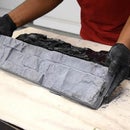Introduction: Backsplash From Reclaimed Pallets
Thanks for stopping by! Check out the video for a more in-depth look.
For this instructable, I am going to make a backsplash from old pallets. The key reason is to hide the unsightly washer hose and electric cords. The backsplash is made to be removable, so that I can easily get behind for service.
To see how I made this backsplash, check out the next step.
Check out my social media sites:
Instagram www.instagram.com/diycreators2015/
Facebook www.facebook.com/diycreators
Youtube: www.youtube.com/c/DIYCreators
Step 1: Picking Out the Pallets
You can find pallets almost anywhere.
For this project, I used various sizes of pallets, but mainly three different sizes.
Since I planed the pallets in my thickness plane, I separated the pallets by size.
You can use a hand-sander for this process, however it will be time-consuming.
(If you are not familiar with a thickness planer, it removes a layer from one side of your lumber.)
Step 2: Ripping the Pallets to Strips
Since there is not a straight side on the pallets. I passed the wood through the table saw to create a straight side.
Once I had at least one straight side, I began to rip the strips.
I set the table saw fence 1.5 inches from the blade, and began the ripping process. I did this until it was all ripped-to-size.
Step 3: Final Cut
I cut off a small piece of wood from the end to make sure the end was straight.
Then, I put stop block on the miter saw, so that every cut was identical at 9-inches long.
I gave an additional sanding on the ends to remote the wood blowouts.
Step 4: Cutting the Back Support
Since my backslash is removable. I used 1/2-inch plywood.
If you wanted to install this permanently 1/4 plywood will be sufficient.
In my case, I added an additional piece to onside to push the back support off the wall to clear the washer hoes.
Step 5: Attaching the Pallets to the Back Support
To keep this sweet and simple I used hot glue to attach the pallets. Of course you can use any method of attaching that you feel is necessary and beneficial.
I wanted a stack stone look, I have three different sizes as a starting point.
First is 9-inch, second is 6-inch, third is 3-inch. Then I repeated the same method every third row.
When I got to the end, I mitered the corner to give it a clean, wrapped look.
Step 6: Adding the Finish
I gave a quick sand to remove the sharp corners.
I use danish oil for the backsplash. Just follow the instructions n on the container. I applied with a rag.
Danish oil - http://amzn.to/1r2rypG
Danish oil, unlike stain, sits in the wood. I only applied one coat, but feel free to apply as many as you like to darken.
Step 7: Installing
As previously stated, this backsplash is removable. So I make a simple wood bracket for one side to lock the backsplash in place.
On the other side, I used the french cleat method to attach. This part was added at a later date.






